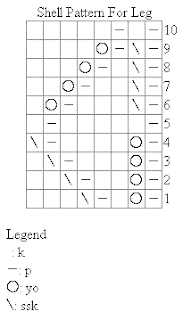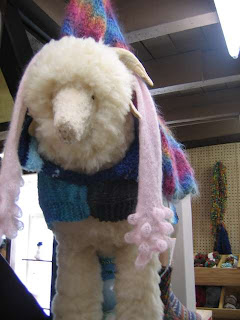Finally!
Meg can now testify that KnitML has actually, truly been useful to her. The Child's French Sock pattern from Nancy Bush's Knitting Vintage Socks only provided written directions, and she thought that a chart would be nice. "Can the Knitimal do this?" she asked. "Why, of course it can!" I replied. Well, at least I suspected it could.
So I entered the part of the pattern she wanted a chart from into the KnitML editor. I crossed my fingers, ran the program and...
Whoosh! It worked!
What's more is that she even commented that it was very attractive looking and that I should take a picture.

At first glance, this isn't all that exciting. There are many programs available today (some of them on the web) that will allow you to type line-by-line instructions and they will convert them into a chart. But if you were to take a closer look at the KnitML pattern, there are two things that are exciting.
The first is the clarity of the KnitML pattern itself. To create this chart, I typed this into a KnitML template file:
Row 1: p1, yo, k1, p1, ssk, k3
Row 2: p1, yo, k2, p1, ssk, k2
Row 3: p1, yo, k3, p1, ssk, k1
Row 4: p1, yo, k4, p1, ssk
Row 5: p1, k5, p1, k1
Row 6: p1, ssk, k3, p1, yo, k1
Row 7: p1, ssk, k2, p1, yo, k2
Row 8: p1, ssk, k1, p1, yo, k3
Row 9: p1, ssk, p1, yo, k4
Row 10: p1, k1, p1, k5
The row-by-row instructions are indistinguishable from a real pattern. That's reason enough to use software from the KnitML Project for your instructions-to-chart conversions. But there's another reason to be excited.
If the pattern were provided to you in KnitML form (by the designer), you wouldn't need to trouble yourself with any of this. You could simply open up the pattern in your KnitML pattern reader, and... voom! All of your preferences would be taken into account, and you would magically have charts if you so desired.
I've told the world about KnitML's chart producing capabilities (well, at least the KnitML Blog and on Ravelry). Unfortunately, I've gotten absolutely no response or feedback from anyone. It's a little disheartening.
Except for Meg, who is finally convinced that this is useful. Sorry it's taking me so long to knit you socks, sweetie!
So I entered the part of the pattern she wanted a chart from into the KnitML editor. I crossed my fingers, ran the program and...
Whoosh! It worked!
What's more is that she even commented that it was very attractive looking and that I should take a picture.

At first glance, this isn't all that exciting. There are many programs available today (some of them on the web) that will allow you to type line-by-line instructions and they will convert them into a chart. But if you were to take a closer look at the KnitML pattern, there are two things that are exciting.
The first is the clarity of the KnitML pattern itself. To create this chart, I typed this into a KnitML template file:
Row 1: p1, yo, k1, p1, ssk, k3
Row 2: p1, yo, k2, p1, ssk, k2
Row 3: p1, yo, k3, p1, ssk, k1
Row 4: p1, yo, k4, p1, ssk
Row 5: p1, k5, p1, k1
Row 6: p1, ssk, k3, p1, yo, k1
Row 7: p1, ssk, k2, p1, yo, k2
Row 8: p1, ssk, k1, p1, yo, k3
Row 9: p1, ssk, p1, yo, k4
Row 10: p1, k1, p1, k5
The row-by-row instructions are indistinguishable from a real pattern. That's reason enough to use software from the KnitML Project for your instructions-to-chart conversions. But there's another reason to be excited.
If the pattern were provided to you in KnitML form (by the designer), you wouldn't need to trouble yourself with any of this. You could simply open up the pattern in your KnitML pattern reader, and... voom! All of your preferences would be taken into account, and you would magically have charts if you so desired.
I've told the world about KnitML's chart producing capabilities (well, at least the KnitML Blog and on Ravelry). Unfortunately, I've gotten absolutely no response or feedback from anyone. It's a little disheartening.
Except for Meg, who is finally convinced that this is useful. Sorry it's taking me so long to knit you socks, sweetie!

Comments
What if you contacted the editors of either Vogue or Interweave Knits? Maybe they could use it for their magazines, or do an article on it?
You're spot on about the tooling. That's one of the things that I hope to address with the Graphical Pattern Editor / Composer. It will ultimately have advanced features such as being able to make suggestions (i.e. "auto assist" and "code completion"). It currently has the previewing capability, and an upcoming release will feature preference customization for the renderer.
I want the tools to get a lot better before I go to a magazine like Interweave, unless one of those magazines would be willing to do a "concept" type article. Most of the work up to this point has been foundational, and frankly I imagine that's pretty boring to most people. :)
Thanks for the offer for help. I suspect that I will take you up on it for the 0.6 release of the core tools. I intend to tackle cables and some other more complicated charting functionality at that time.